AI Adoption: How Businesses Are Adopting AI [Trends & Benefits]

Finney Koshy
Product Owner
![AI Adoption: How Businesses Are Adopting AI [Trends & Benefits]](https://cdn.sanity.io/images/sr38gnla/production/aed765f91553827eeefc6f177762a043aa072435-1300x681.webp?w=1000&fm=webp&q=75)
Share to AI
Ask AI to summarize and analyze this article. Click any AI platform below to open with a pre-filled prompt.
AI is fundamentally changing how business is done across entire industries, with 78% of organizations now using AI in some capacity. But why are so few businesses getting real business value from their AI tools? The answer lies in how they approach AI adoption.
At Aloa, we build custom AI solutions that solve real business problems, from computer vision and machine learning to agentic AI systems and fine-tuned language models. We’ve seen firsthand how the right AI adoption approach changes everything.
This comprehensive guide breaks down:
- The current trends in AI adoption.
- The real benefits companies are seeing from strategic adoption of AI.
- How to implement AI the right way.
Ready to turn AI from buzzword to bottom-line results? Let's dive in.
Understanding AI Adoption
AI adoption encompasses every form of AI integration into business operations to automate tasks, enhance decision-making, and create new value streams.
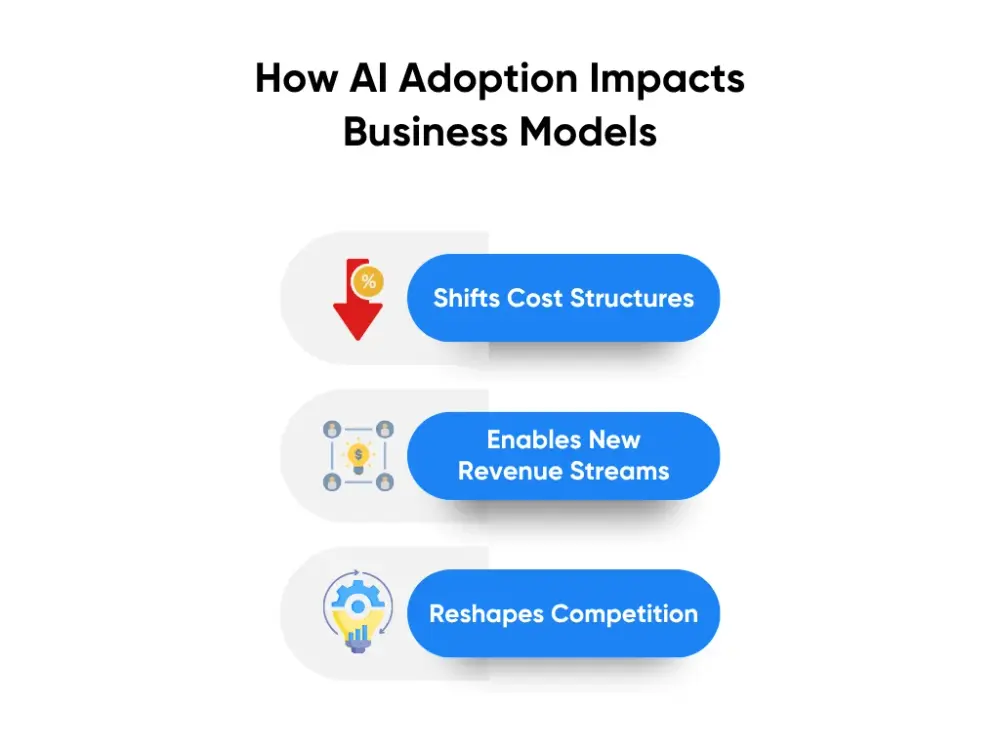
How AI Adoption Impacts Business Models
- Shifts cost structures: By automating manual processes, companies typically see 10-15% operational cost reductions in their first year.
- Enables new revenue streams: AI enables more personalized products and data-driven services that were previously unfeasible. This adds extra value for customers.
- Fundamentally changes competitive dynamics: AI creates sustainable advantages through better customer insights and faster innovation cycles.
Trends in AI Deployment
In 2025, AI deployment is evolving more rapidly than ever. Beyond rote task automation, AI deployment now involves comprehensive strategies to overhaul entire business systems.
Organizational Restructuring for AI
Smart companies are completely restructuring how they organize around AI. The most successful approach? Create AI Centers of Excellence (CoEs) that act as internal consulting firms. Big companies like Microsoft and JP Morgan are all forming central teams that establish standards, provide training, and ensure AI initiatives align with business goals. This thought process can be applied to businesses of all sizes.
We're seeing three winning CoE models emerge.
- Mid-sized companies (50-500 employees): Thrive with centralized AI teams that provide tools and standards while letting business units implement solutions.
- Rapidly scaling startups: Often prefer federated models, distributing AI capabilities across teams with central governance.
- Companies with diverse business lines: Succeed with hub-and-spoke structures, where a central AI hub provides shared services to specialized business functions.
Governance and Leadership in AI
AI governance has moved from the IT department to the boardroom, and leading companies demonstrate this approach effectively.
Meta exemplifies large-scale AI adoption with distributed governance across its platforms. Microsoft and Google have established AI ethics committees with clear review processes.
Research shows organizations with strong AI governance frameworks are significantly more likely to achieve their AI objectives. A multi-leveled approach ensures regulatory compliance with data privacy requirements, ethical AI deployment, and risk mitigation across all business functions. Leading companies establish clear governance frameworks with three layers:
Strategic oversight at the board level
Operational management through AI CoEs
Tactical execution by project teams
The most effective governance structures include legal, risk, and business stakeholders from day one. At Aloa, we've seen firsthand how governance makes or breaks AI projects. 60% of AI initiatives fail largely due to poor governance. The 40% that succeed establish clear data usage policies, define ethical guidelines, and create accountability structures before they write their first line of code.
Benefits of AI Adoption
When implemented correctly, the new tools introduced by AI can deliver revolutionary benefits across four critical business dimensions.
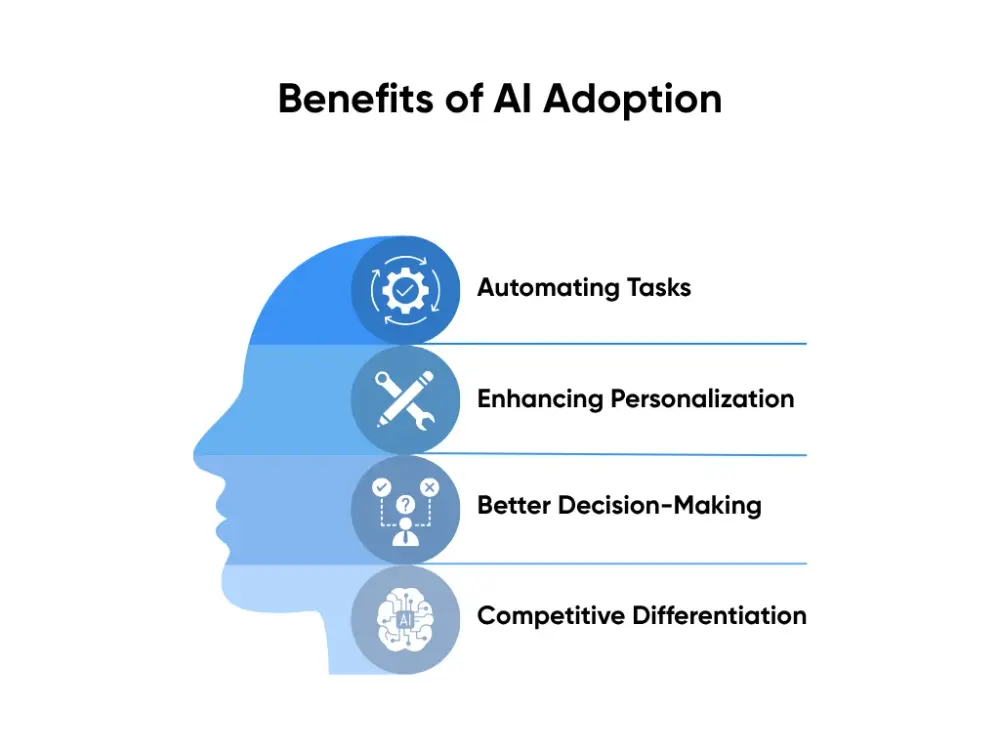
Automating Tasks
Automating routine processes like invoice processing and customer support provides immediate, measurable value. Customer service AI increases issue resolution by 14% per hour while reducing handling time by 9%. Invoice processing that once took hours now gets done in minutes.
Enhancing Personalization
Traditionally, creating personalized experiences required proportional increases in resources. If you wanted to personalize content for twice as many customers, you needed roughly twice the staff, time, and budget, creating a fundamental scaling problem where more customers meant exponentially higher costs.
AI eliminates this constraint by enabling Netflix-level customization for millions of customers simultaneously through the same core system. Dynamic pricing adapts to individual customer behavior in real-time, geo-targeted content delivers relevant experiences based on location and preferences, and behavioral predictions anticipate customer needs, all without requiring additional human resources for each new customer segment.
Enabling Better Decision-Making
AI processes vast datasets in real-time, revealing patterns that human analysts would take weeks to uncover. The latest AI trends in 2025 are showcasing how beneficial this is to everything from the public sector to scientific research, augmenting the abilities of data scientists and accelerating R&D.
Likewise, AI is dramatically improving the speed and accuracy of financial forecasting and risk detection algorithms. At Aloa, we've seen companies reduce forecast delivery time by 30% while increasing precision.
Competitive Differentiation
Mixed with creativity and ingenuity, AI enables capabilities that competitors simply cannot match. Like getting a head start in a race, AI widens the competitive gap between you and your competitors. Without equally effective AI adoption and utilization, they’ll be hard-pressed to close this gap.
With over 80% of businesses now using AI in some capacity, AI adoption is now an absolute necessity to get ahead. Businesses that wait too long will find themselves competing against technology companies that were built with AI from day one. These AI-first competitors will be faster, smarter, and more efficient. The opportunity to catch up is here now, but it's shrinking every day
You can read about how Aloa has helped businesses implement AI in each industry at our AI industry solutions page, where we showcase successful AI transformations across financial services, healthcare, real estate, and other sectors that demonstrate the critical importance of strategic AI adoption for maintaining market relevance.
Challenges and Risks in AI Adoption
Despite the promising benefits, AI adoption comes with significant challenges and potential risks that demand proactive management strategies.
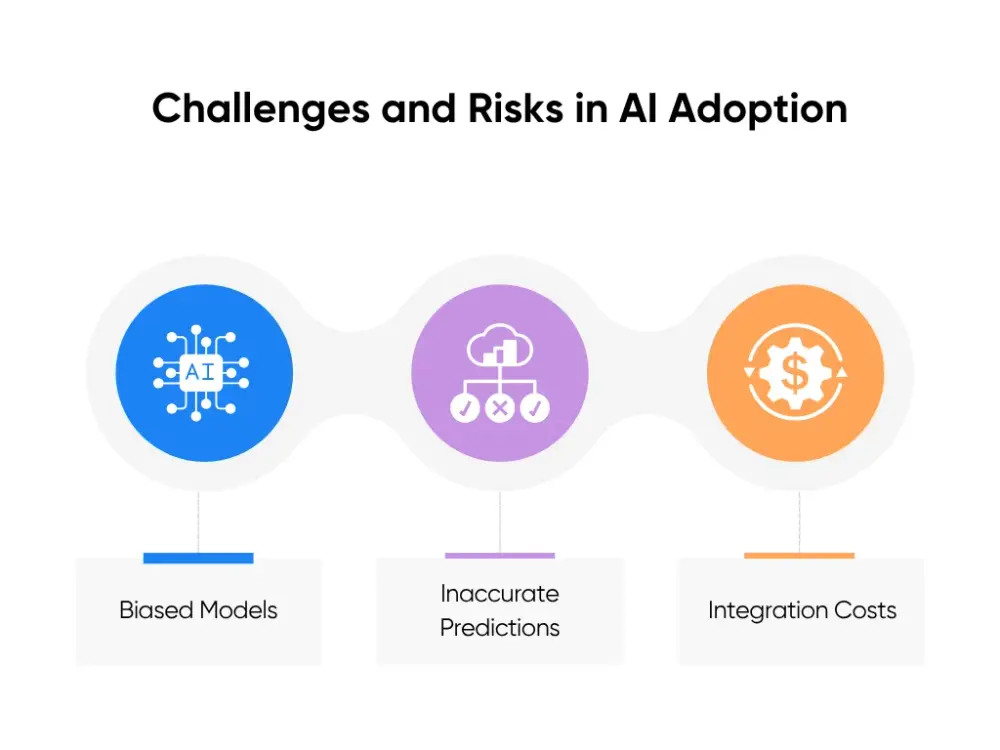
Biased Models
Model bias is one of the most insidious risks. Amazon had to discontinue its AI recruiting tool after it penalized resumes containing "women's" and downgraded candidates from women's colleges. MIT research found a similar problem where facial recognition systems had a 34% error rate for darker-skinned women, but only 0.8% for light-skinned men.
Major tech companies like Google, Microsoft, and IBM are treating model bias as one of their top priorities. IBM has released open-source fairness toolkits like AI Fairness 360, which help developers implement diverse training datasets and bias tests. Google’s “What-If” tool allows developers to visualize and compare AI model predictions across different demographic groups, making it easier to identify differences in decision-making.
Inaccurate Predictions
As business strategies rely more heavily on AI for predictive analytics, incorrect predictions can have catastrophic results. Errors in Zillow’s real estate AI algorithms, for example, led to $500+ million losses when their system overestimated home values, forcing the company to shut down Zillow Offers and lay off 25% of its workforce.
In another example, IBM Watson for Oncology was discontinued due to unsafe treatment recommendations. These failures share common patterns: insufficient testing, overconfidence in models, and inadequate human oversight.
Smart AI adopters overcome this with gradual deployment strategies starting with low-risk pilot programs before scaling. A great example of an organization doing this successfully is Atlantic Health System, which implemented clear business KPIs for a small imaging evaluation system pilot. Starting in their neurology department, this quickly scaled out to cardiology and other areas, creating a successful pilot in eight weeks before broader implementation.
Integration Costs
AI integration doesn’t come cheap. Initial investments range from $5,000-$30,000 for small businesses to $1-10+ million for enterprise AI adoption. Up to 30% of that goes to data preparation, and AI specialist salaries also take up a large chunk at $90,000 to $300,000 each year. If your infrastructure isn’t AI-ready, updating it can add 30-50% to overall costs.
A phased approach is one of the best ways to manage costs. 70% of companies start with cloud-based AI services to avoid large upfront infrastructure investments. Many companies also focus on high-ROI use cases first to quickly prove the tech and gain funding for the rest of the integration process.
Practical Steps for Successful AI Integration
Because AI is such a groundbreaking tech, integrating AI inevitably requires you to change how your organization operates and competes. Successful AI integration requires a methodical, phased approach that prioritizes people and processes over technology.
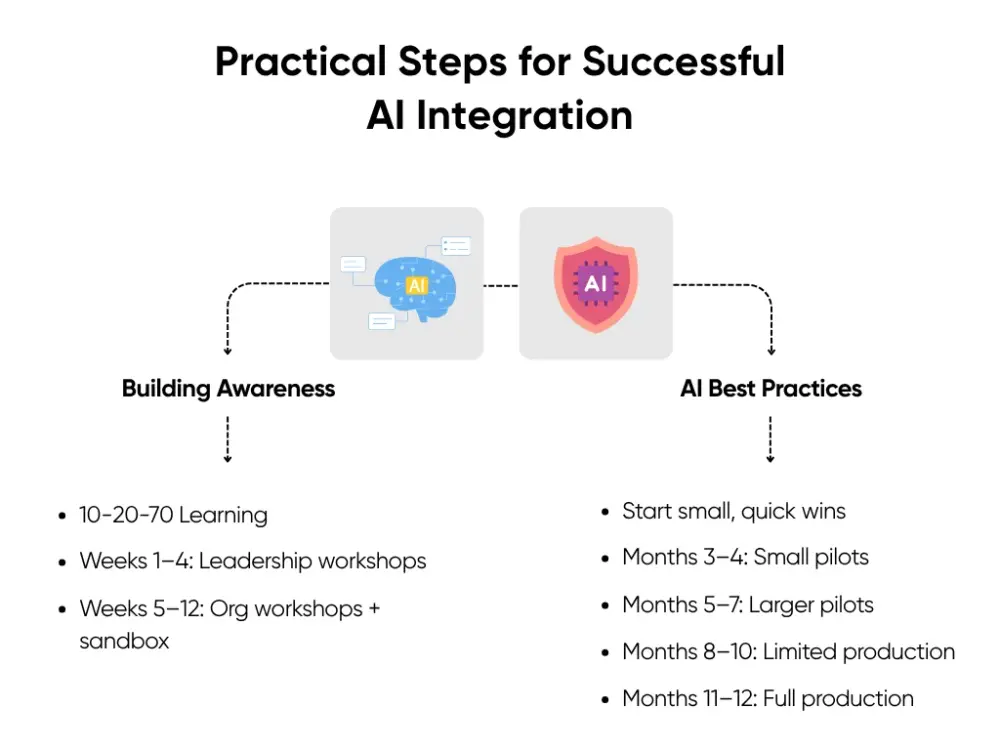
Building Internal Awareness
Begin your integration journey with education, following the proven 10-20-70 rule: 10% formal training, 20% learning from interaction, and 70% learning from experience. At Aloa, we've found that companies investing in comprehensive education see 40% higher adoption rates across all subsequent AI initiatives.
Begin with leadership education in the first 4 weeks, with executive AI workshops and competitive landscape assessment. Then, expand to organizational awareness in weeks 5 through 12, with department-specific workshops and hands-on exploration in sandbox environments.
MIT research shows that starting with "safe" AI applications builds trust while peer learning accelerates adoption.
Implementing AI Best Practices
The "start small, scale fast" philosophy guides every successful implementation. Begin with high-impact, low-complexity use cases that deliver quick wins and build organizational confidence. Common applications like document summarization are low-risk, with 4-8 week timelines and budgets ranging from $2,000 to $5,000.
At Aloa, we’ve found that the best implementations follow this general scaling pattern:
- Months 3-4: Limited pilot projects with 10-50 users
- Months 5-7: Broader pilots with 50-200 users
- Months 8-10: Limited production with full user base but constrained functionality
- Months 11-12: Full production organization-wide
Focus on 3-5 high-impact use cases rather than spreading efforts across numerous small projects. Leading companies concentrate on fewer use cases, averaging at 3.5 use cases, with those lagging behind averaging at 6.1 use cases.
The Future of AI in Business
The AI landscape continues evolving at a breakneck pace, with several trends reshaping how businesses will operate from 2025 through the end of the decade.
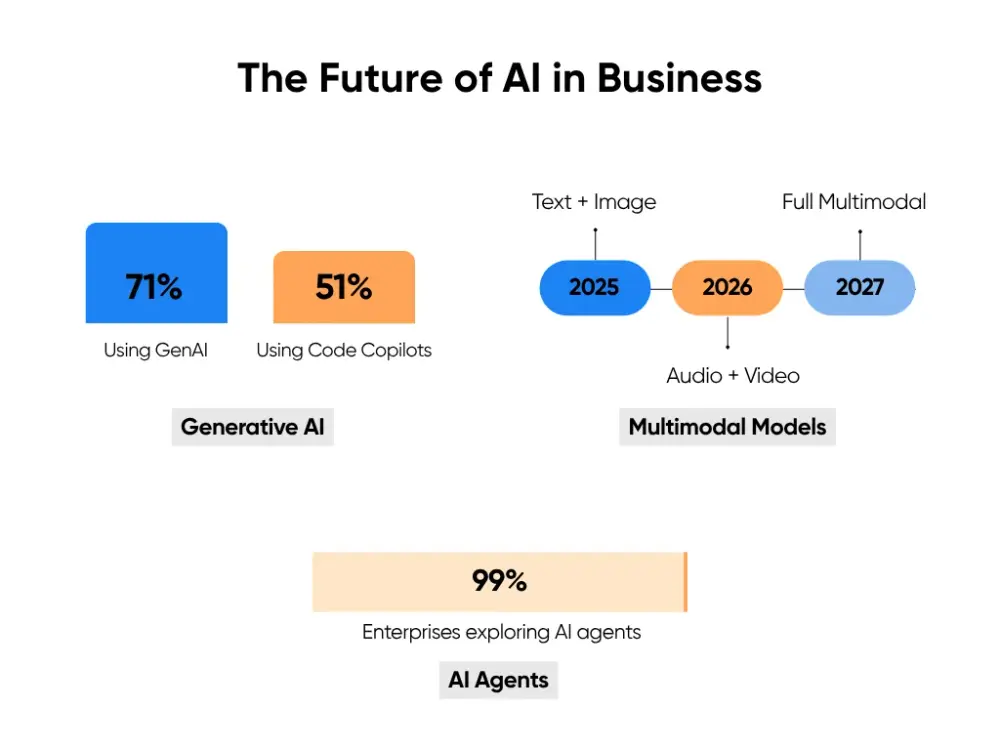
Generative AI
71% of organizations now use generative AI regularly, and it's changing how work gets done. Your employees are probably already using tools like ChatGPT or similar AI assistants, but the real business impact comes from companies that invest seriously.
Those spending $50M+ annually see over 10% cost savings with payback periods of 6-12 months for basic productivity improvements. Your content teams will produce more in less time, your customer service can handle inquiries faster, and your sales teams can personalize outreach at scale.
Multimodal models
Today's AI can already understand text, images, and code at the same time. By next year, AI will seamlessly handle audio and video too. By 2027, your business systems will process all types of content as easily as reading an email, from documents and photos to voice calls and video meetings.
Imagine your customer service AI watching a video complaint and instantly understanding both what the customer is saying and what they're showing you. Your staff won't need to manually type up a report based on that content. Instead, AI will generate one automatically and immediately send it to the proper departments, letting them respond to the complaint near-instantly.
AI agents
Even though they’re still at peak hype, AI agents are already achieving real value creation. Many believe that agentic AI will be the next productivity frontier. 99% of enterprise AI developers are exploring agents, with applications spanning customer service ticket resolution, HR automation, virtual assistants, financial operations, and sales processes.
Within two years, you'll have AI agents independently handling complex processes from start to finish: processing returns, onboarding new employees, or managing vendor relationships. Without needing to micromanage the AI, your employees' roles will shift dramatically. Instead of doing routine tasks, they'll focus on strategy, relationship building, and creative problem-solving.
Key Takeaways
With AI becoming more and more commonplace, AI adoption is now a strategic necessity. You’re much more likely to succeed if you:
- Start by focusing on 3-5 high-impact use cases.
- Invest 70% of your efforts in people, training, and processes.
- Establish clear governance frameworks early on.
- Start with proven applications like customer service automation or code assistance.
Want to actually win with AI? Aloa helps growing companies like yours implement AI the right way. Whether you need a fraud detection algorithm or automated medical imaging, we can deploy full-featured AI systems that integrate with your existing systems. Contact us today for a quote on your next winning solution.
FAQs
What is AI adoption?
AI adoption is the process of integrating artificial intelligence technologies into business operations to automate tasks, enhance decision-making, and create new value streams. It involves organizational transformation as well as digital transformation.
How does AI governance affect ROI?
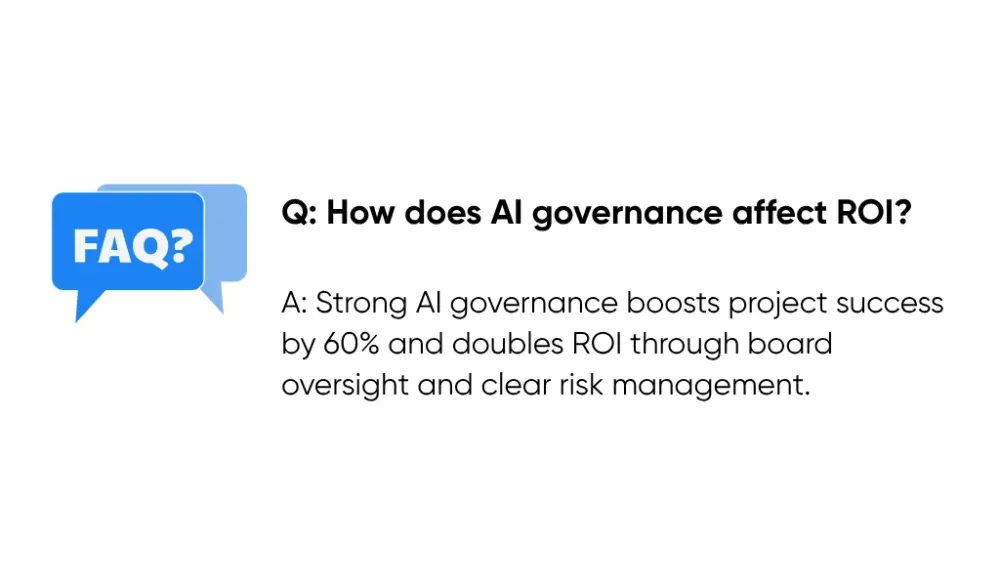
Strong AI governance increases project success rates by 60% and ensures sustainable returns. Companies with board-level AI oversight and clear risk management frameworks see twice the ROI compared to those without structured governance.
What are the top risks in AI adoption?
The three biggest risks are biased models (which can cause legal and reputational damage), inaccurate predictions (leading to costly business decisions), and spiraling integration costs (which can exceed budgets by 300-500%).
How can you integrate AI across departments?
Start with AI Centers of Excellence that provide standards and training. Use a hub-and-spoke model where a central AI team supports department-specific implementations. Focus on cross-functional collaboration and change management from day one.
What's the future of generative AI in business?
The economic potential of generative AI is immense. Experts expect it to become the foundation for multimodal experiences (text, image, audio, video) by 2027. AI agents will handle increasingly complex autonomous tasks, fundamentally changing how businesses operate and compete in every industry.